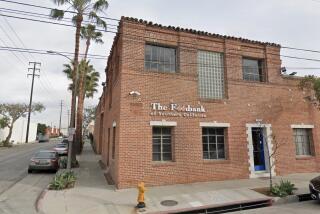Food pantries are feeling the pinch
Thousands of people turn to the Lutheran Social Services Community Care Center in Van Nuys for help putting food on the table.
Last week, a sign went up on the door: “We’re sorry but we ran out of food.”
With demand for assistance continuing to rise, officials at many Los Angeles County food pantries say they have had to reduce what they offer or turn away people in need.
About 284,000 county residents are served each month at the 500 pantries supplied by the Los Angeles Regional Foodbank, according to figures from April, May and June. That is nearly 21% more people than in the same months last year and 48% more than in 2008.
“We’re distributing more food to local pantries than ever before, yet it’s still not enough to keep pace with the growing need in the community,” Michael Flood, the food bank’s president, said in a statement last week.
The food bank has increased the volume of commodities it distributes by 62% in the last two years with help from the U.S. Department of Agriculture, grocery stores and community food drives. An effort to acquire more fresh fruit and vegetables also contributed to the increase, Flood said during a news conference Thursday.
The food bank distributes 1.1 million pounds of food each week through pantries and other charitable organizations, equivalent to about 800,000 meals. But Flood said he still hears from pantries that have had to reduce the size of their food packages or send people away empty-handed.
The St. Francis Center frequently runs out of fresh fruit and vegetables for the more than 200 downtown Los Angeles residents it serves each week, many of them families in low-income housing and elderly people.
“They just take a few cans or the one vegetable that we have,” said program assistant Maribel Ramos. “Yet they still come, which means they really do need it.”
Staffers at the Lutheran center did not want to reduce their allotments for needy families, deciding instead to close their doors when supplies ran out at 11:20 a.m. Aug. 25. The pantry reopened the next afternoon after receiving a delivery from the food bank.
It was the third time that occurred this year, said Jan Maseda, the center’s director. She said the center was getting fewer contributions from grocery stores and speculated that markets were stocking less food.
But she said the main reason for the shortfall was the number of people seeking aid. The center served about 16,750 people in 2008 and more than 32,000 in 2009. This year, the trend continues.
“We haven’t even hit our heaviest months, and we have already surpassed 32,000,” Maseda said.
She attributed the growing demand in part to reduced work hours and persistent unemployment, which are driving many professionals to seek help for the first time.
“If you come on a busy day, you see lots of late model cars in the parking lot,” she said. They belong to teachers, set designers and other skilled people who “just aren’t making it any more.”
Cuts to state grants for low-income families, the elderly and the disabled are also driving more people to food pantries, she said.
Consuelo Ramirez said she supported herself for 40 years but has been unable to find work since she was laid off by a commercial cleaning company more than a year ago.
“I came because my refrigerator is empty,” she said as she waited in line Friday at the Lutheran center.
This time, the shelves were full and Ramirez walked away with three bags filled with bread, rice, tomatoes and cake to feed herself and her 87-year-old father.
Other pantries don’t have as much, she said. “Sometimes they only give you one bag.”
Flood said many pantries appear to be reaching capacity after sharply increasing the number of food packages they distributed between 2008 and 2009.
Food availability is not the only constraint, he said. Some pantries are also reaching the limit of what they can do with their available space, volunteers and funding. He emphasized the need to sign up more Californians for federal food stamps, saying it would ease the pressure on pantries.
Although participation in the food stamp program has increased steadily since the recession began, California has typically lagged behind most other states. Fewer than half the eligible Californians received the benefit in 2007, the most recent year for which federal estimates are available.
The Los Angeles County Department of Public Social Services has stationed outreach workers at pantries and other community sites to help people apply for food stamps, said Jacob Aguilar, a department assistant director. He urged anyone in need of nutrition assistance to call (877) 597-4777 for information about food stamps and other programs.
alexandra.zavis@latimes.com
More to Read
Sign up for Essential California
The most important California stories and recommendations in your inbox every morning.
You may occasionally receive promotional content from the Los Angeles Times.









